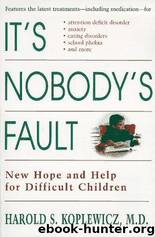It's Nobody's Fault: New Hope and Help for Difficult Children and Their Parents by Harold Koplewicz

Author:Harold Koplewicz
Language: eng
Format: mobi, epub
Tags: Parenting, Medical, General, Family & Relationships, Child & Adolescent, Psychiatry
ISBN: 9780812929218
Publisher: Random House, Inc.
Published: 2010-08-15T07:00:00+00:00
THE BRAIN CHEMISTRY
Certain children are born with a genetic predisposition for social phobia. In plain English: excessive shyness runs in families. Supporting this theory is the fact that if one twin has social phobia, the other is more likely also to have it if he or she is an identical twin (with the same genetic makeup) rather than fraternal (with similar but not identical genes)—even if the twins are raised apart. Children adopted at an early age show a great similarity to their biological mothers on ratings of shyness. Parents of behaviorally inhibited children, kids who are fearful or withdrawn in new or unfamiliar situations are much more likely to have social phobia or to have had the disorder as children than are parents of normal or uninhibited youngsters.
What specific brain chemistry do children with social phobia have? As always, we can’t be sure, but we can make an educated guess. Most probably the brain has too much norepinephrine and not enough serotonin. Certainly the effective medication for this disorder supports that theory. The medications that are most useful in the treatment of social phobia are the MAOIs (monamine oxidase inhibitors) and the SSRIs (selective serotonin reuptake inhibitors), both of which have an impact on norepinephrine and serotonin. TCAs (tricyclic antidepressants) have no effect on this disorder.
The animal model adds support to the argument. Studies done with rhesus monkeys have been able to identify two different behavioral styles—laid-back or uptight—and to determine that the uptight monkeys have a different brain chemistry from those who are laid-back. When given an SSRI, the uptight monkeys become more sociable and more comfortable, more like their laid-back fellow monkeys.
There’s some evidence that with social phobia “nurture” plays a part as well as “nature.” The basic assumption is that infants come into the world with a predisposition for anxiety. After that, any of several scenarios are possible. For example, a temperamentally inhibited infant is very reactive and hard to comfort, and a parent may find this distressing and be less attentive. The lack of attention affects the parent-child relationship, of course, and it may make the child insecure and less inclined later on to participate in other social contacts. To take another example, a shy mother or father with a shy infant is less likely to expose that child to social situations, so the child never learns to be comfortable socially. His parent, not wanting to cause the child discomfort, continues to “protect” him from the outside world. In both of these examples the children, with limited social experience, become even more anxious.
Download
It's Nobody's Fault: New Hope and Help for Difficult Children and Their Parents by Harold Koplewicz.epub
This site does not store any files on its server. We only index and link to content provided by other sites. Please contact the content providers to delete copyright contents if any and email us, we'll remove relevant links or contents immediately.
| Allergies | Asthma |
| Autism & Asperger's Syndrome | Cystic Fibrosis |
| Down Syndrome | Eating Disorders |
| Epilepsy | Learning Disorders |
| Lice | Special Needs Children |
I Capture the Castle by Dodie Smith(1985)
Aspergirls by Rudy Simone(1655)
Be Different by John Elder Robison(1603)
Autism's False Prophets by Paul A. Offit(1496)
My Child's Different by Elaine Halligan(1462)
Smart but Scattered—and Stalled by Richard Guare(1457)
101 Tips for the Parents of Boys with Autism by Ken Siri(1436)
What's Making Our Children Sick? by Michelle Perro(1384)
Asperger Syndrome (Autism Spectrum Disorder) and Long-Term Relationships by Ashley Stanford(1378)
ADHD by Mark Selikowitz(1353)
On Immunity: An Inoculation by Biss Eula(1338)
Girlish by Lara Lillibridge(1335)
Nerdy, Shy, and Socially Inappropriate by Cynthia Kim(1310)
An Adult with an Autism Diagnosis by Gillan Drew(1306)
Animal-assisted Interventions for Individuals with Autism by Temple Grandin(1283)
Sarah's Child (Hqn Romance) by Linda Howard(1272)
Seeing Ezra by Kerry Cohen(1263)
The Cities by K.A Knight(1238)
Why Gender Matters by Leonard Sax M.D. Ph.D(1221)
